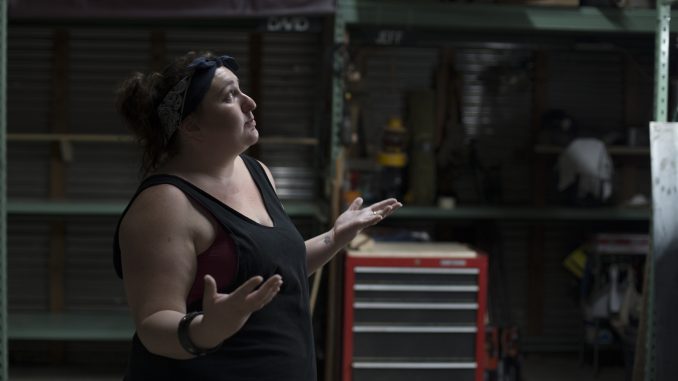
Sturdy, speckled rubber boots climb a short flight of stairs and ascend toward the ceiling of the Philadelphia Sculpture Gym.
The highest pair of shoes, suspended in the air by thin wire and dotted with duct tape once belonged to Butch Price, a shipyard owner and operator. Artist Brian Wagner said Price had a habit of taping the boots to his jeans while cleaning ships on the Gulf of Mexico after the British Petroleum oil spill.
“[Butch and his wife’s] resilience in spite is so humbling to me,” Wagner said. “They just keep on working, kept on doing, kept on living.”
This month, the Sculpture Gym, a gallery, studio, and hub for art classes that includes a gym-like membership policy, pays homage to the unsung hero with its exhibition “Sweat and Blood,” a conceptual display of work apparel and equipment.
“[The laborer is] so unappreciated and overlooked, but he’s so vital to our society,” director Abbey Gates told gallery goers when the exhibition was unveiled on the first Friday of the month—a tribute to Labor Day weekend.
The exhibit displays the life of the worker firsthand using his own apparel and equipment. Wagner, along with former gallery owner Steven Earl Weber, collected the broken-in materials used in the everyday lives of butchers, coal miners, welders, painters and other blue collar figures. To acquire the materials—and the stories that went with them—Wagner and Weber found and interviewed unsuspecting workers whenever they could.
After each worker donated time and clothes to the artistic cause, he received a new American-made replacement for his old equipment.
The artists displayed the work deliberately to sanctify the life of the laborer. Gates likened a faded work shirt, spread wide and flattened beneath a sheet of glass, to the iconic Shroud of Turin.
To the side of the gallery’s entrance, an upside-down miner’s cap, nailed to a vertical slab of wood, holds a puddle of water—reminiscent of an offering of holy water one would encounter in a church.
“That sold it for me,” Gates said. “That was just the coup de grâce.”
About nine years ago, Gates began college at the University of Delaware with a focus on graphic design. Instead, she finished school as a sculptor, working with a ceramics professor.
Her former professor, featured artist at the Gym, Weber, became her colleague and introduced her to the Sculpture Gym.
Gates said she became enamored with the physical labor that came with creating three-dimensional art.
“You hold it more personal, I guess … you’re putting yourself out there because this took sweat and blood,” Gates said.
While Wagner and Weber focused upon laborers rather than fine artists, Gates said a link between the two exists. It’s not uncommon, Gates said, for an artist to pick up a second or third job to maintain financial sustainability.
The artist is the laborer—they take time out of their lives to have an artistic mindset, to want to create a message and put something out into the world that takes a step beyond, “‘I’m going to go do my job and go home,’” Gates said.
The exhibit will run until Sept. 25.
Angela Gervasi can be reached at angela.gervasi@temple.edu.


Be the first to comment